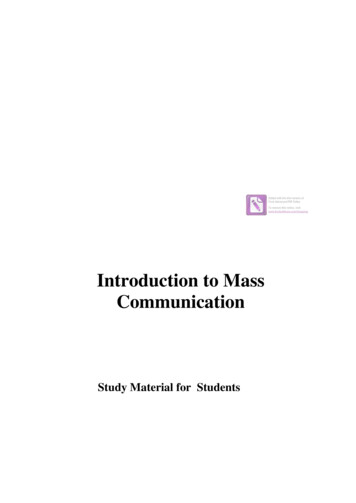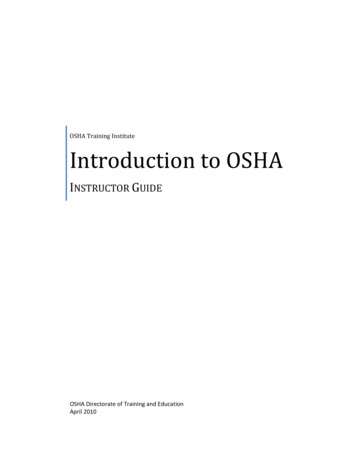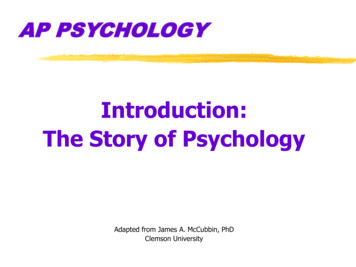
Transcription
Boston College -- Office of University Mission and MinistryCatholicism : IntroductionBY RICHARD MCBRIENPublished in Catholicism. 1994 by HarperCollins Publishers. Used with permission of theauthor."WHAT IS CATHOLICISM?"The Meaning of the WordCatholicism is a rich and diverse reality. It is a Christian tradition, a way of life, and acommunity. That is to say, it is comprised of faith, theologies, and doctrines and ischaracterized by specific liturgical, ethical, and spiritual orientations and behaviors; at thesame time, it is a people, or cluster of peoples, with a particular history.The word Catholic is derived from the Greek adjective, katholikos, meaning "universal," andfrom the adverbial phrase, kath' holou, meaning "on the whole." The term was first used bySt. Ignatius of Antioch (d.c.107) in his Letter to the Smyrnæans: "Where the bishop is to beseen, there let all his people be; just as wherever Jesus Christ is present, we have the catholicChurch" (n.8). Ever since the Reformation, the word has commonly been used in oppositionto Protestant, but its real opposite is sectarian, which pertains to a part of the Church that hasseparated itself off from the worldwide Church and, to some extent, from the world itself.Thus, St. Augustine (d. 430) contrasted the separatist and sectarian movements of his time,especially Donatism in North Africa, with the Catholic Church that is both universal andorthodox in its faith. In his letter to Honoratus, a Donatist bishop, he wrote: "Do youhappen to know why it should be that Christ should lose his inheritance, which is spreadover the whole world, and should suddenly be found surviving only in the Africans, and notin all of them? The Catholic should exist throughout the whole world. Whereas your party,which is called the party of Donatus, does not exist in all those places in which the writingsof the apostles, their discourse, and their actions have been current" (Epistle 49, n. 3).http://www.bc.edu/offices/mission/1
Boston College -- Office of University Mission and MinistrySt. Cyril of Jerusalem (d. 386) was even more explicit: "The Church is called 'Catholic'because it extends through all the world. . . because it teaches universally and withoutomission all the doctrines which ought to come to human knowledge. . .because it bringsunder the sway of true religion all classes of people, rulers and subjects, learned and ignorant;and because it universally treats and cures every type of sin. . .and possesses in itself everykind of virtue which can be named.and spiritual gifts of every kind" (CatecheticalLectures,18, n. 23).The word Catholic was incorporated into the creeds along with the other notes of theChurch: one, holy, and apostolic. It appears in the Creed of Cyril of Jerusalem, the Creed ofEpiphanius (d. 403), and in the Nicene-Constantinopolitan Creed (381) that is still recitedin the liturgy today.But the use of the word Catholic became divisive after the East-West Schism of the eleventhcentury and the Protestant Reformation of the sixteenth century. The West claimed for itselfthe title Catholic Church, while the East, which severed the bond of communion with Rome,appropriated the name Holy Orthodox Church. After the ruptures of the Reformation those incommunion with Rome retained the adjective Catholic, while the churches that broke withthe papacy were called Protestant. However, some today insist that theadjective Catholic applies also to many other Christians who regard themselves as evangelical,reformed, and Catholic alike. Indeed, the Second Vatican Council (1962-1965) broadenedthe notion of catholicity to include churches outside the Catholic Church (DogmaticConstitution on the Church, n. 8), and spoke of them as possessing varying "degrees" ofcatholicity (Decree on Ecumenism, n.3).Catholic or Roman Catholic?There is another, still unresolved, aspect to the controversy, however. Are Catholics who arein communion with Rome Roman Catholics or just plain Catholics? Some inside as well asoutside the Catholic Church think it ecumenically insensitive to drop the adjective Romanbecause so many Anglican, Orthodox, Protestant, and Oriental Christians also regardthemselves as Catholic. But other Catholics object to the use of the adjective Roman onhttp://www.bc.edu/offices/mission/2
Boston College -- Office of University Mission and Ministryecclesiological grounds. For such Catholics Roman tends to confuse rather than define thereality of Catholicism.The history of the Church begins with Jesus' gathering of his disciples and with the postresurrection commissioning of Peter to be the chief shepherd and foundation of the Church-but in Jerusalem, not in Rome. Therefore, it is not the Roman primacy that givesCatholicism one of its distinctive marks of identity within the family of Christian churches,but the Petrine primacy. The adjective Roman applies more properly to the diocese, or see, ofRome than to the worldwide Church which is in union with the Bishop of Rome. Indeed, itstrikes some Catholics as contradictory to call the Church Catholic and Roman at one andthe same time.Eastern-rite Catholics who are in union with Rome (sometimes pejoratively called Uniates)also find the adjective Roman objectionable. They prefer to speak of their churches asCatholic and then to distinguish particular ecclesial traditions within the Catholiccommunion. In addition to the Latin, or Roman, tradition, there are seven other non-Latin,non-Roman ecclesial traditions: Armenian, Byzantine, Coptic, Ethiopian, East Syrian(Chaldean), West Syrian, and Maronite. Each of these is a Catholic church in communionwith the Bishop of Rome; none of these is a Roman Catholic church. Catholicism, therefore,is neither narrowly Roman nor narrowly Western. It is universal in the fullest sense of theword.It should be evident from the title of this book (Catholicism rather than Roman Catholicism)which argument the author finds more compelling. To choose one side, however, is notnecessarily to reject the other. One can apply the term Catholic to the community ofchurches in union with Rome without precluding its wider application to Anglicans,Orthodox, Protestants, and Oriental Christians. At the same time, Catholics can reject theadjective Roman without lapsing into ecclesiastical triumphalism. What is important is thateach side explain and support the reasons for the position taken.http://www.bc.edu/offices/mission/3
Boston College -- Office of University Mission and MinistryThe Context of CatholicismCatholicism is not a reality that stands by itself. The word Catholic is not only a noun but anadjective. As an adjective it is a qualification of Christian, just as Christian is a qualificationof religions, and religions is a qualification of human. Thus, Catholicism refers to acommunity of persons (the human dimension), who believe in God and shape their livesaccording to that belief (the religious dimension), who believe that God to be triune, andJesus Christ to be the Son of God and the redeemer of humankind (the Christiandimension), who express and celebrate that belief in the Eucharist and who recognize theBishop of Rome to be "the perpetual and visible source and foundation of the unity of thebishops and of the multitude of the faithful" [Dogmatic Constitution on the Church, n. 23](the ecclesial dimension). To be Catholic, therefore, is to be a kind of human being, a kindof religious person, and a kind of Christian belonging to a specific eucharistic faithcommunity within the worldwide, or ecumenical, Body of Christ.To be Catholic is, before all else, to be human. Catholicism is an understanding, affirmation,and expression of human existence before it is a corporate conviction about the pope, or theseven sacraments, or even about Jesus Christ and redemption. The first theological questionswe ask ourselves are, "Who am I?" and "Who are we?" Every other theological questioncomes back to these. We cannot understand God, or Jesus Christ, or the Church, oranything else unless and until we come to terms with the question of ourselves. (The widerhuman context of Catholicism is treated in Part One, chapters 35. Its distinctively Catholicmoral and spiritual outcomes are treated in Parts Six and Seven, chapters 25-31.)But Catholicism is more than a corporate understanding, affirmation, and expression of whatit means to be human. Catholicism answers the question of meaning in terms of ultimacy.With the Lutheran martyr Dietrich Bonhoeffer (d. 1945), Catholicism affirms that there ismore to life than meets the eye, that there is "a beyond in our midst" (Letters and Papers fromPrison). With Paul Tillich (d. 1965), one of the most prominent and influential Protestanttheologians in the twentieth century, Catholicism affirms that there is a "ground of being"which is Being itself (Systematic Theology). With St. Thomas Aquinas (d.1274), Catholicismhttp://www.bc.edu/offices/mission/4
Boston College -- Office of University Mission and Ministryaffirms that all reality is rooted in the creative, loving power of that which is most real (ensrealissimum). Catholicism answers the question of meaning in terms of the reality of God. Inbrief, Catholicism is a religious perspective, and not simply a philosophical or anthropologicalone. Catholicism offers an understanding of God, and that understanding is the foundationand context for its understanding of creation, redemption, incarnation, grace, the Church,moral responsibility, eternal life, and each of the other great mysteries and doctrines ofChristian faith. The doctrine of the triune God is what Christian and Catholic faith is allabout. (The wider religious context of Catholicism is treated in Part Two, chapters 6, 7, and10.)But Catholicism is not some undifferentiated religious view. It is a form of Christian faith,alongside Protestantism, Anglicanism, Orthodoxy, and Oriental Christianity. Catholicism'sunderstanding of and commitment to God is radically shaped by its understanding of andcommitment to Jesus Christ. For the Christian the ultimate dimension of human experienceis a triune God: a God who creates and sustains us and who identifies with our historicalcondition, and a God who empowers us to live according to the vocation to which we havebeen called. More specifically, the God of Christians is the God of Jesus Christ. (The widerChristian context of Catholicism is treated in Part Two, chapters 89, and Part Three,chapters 11-15.)However, just as Jesus Christ gives access to God, so, for Catholicism, the Church givesaccess to Jesus Christ. Catholicism has an ecclesial dimension. But the Church is composed ofmany churches. The Church universal is the communion of local, or individual, churches(denominations, dioceses, patriarchates). Thus, the noun church is always modified: theCatholic Church, the Baptist Church, the Orthodox Church, the Lutheran Church, and soforth. Moreover, even these modifiers can themselves be modified: the Maronite CatholicChurch, the Southern Baptist Church, the Russian Orthodox Church, the LutheranChurch/Missouri Synod, and so forth.There are many churches, but one Body of Christ. For Catholicism, however, within thecommunity of churches there is one Church that alone fully embodies and manifests all ofhttp://www.bc.edu/offices/mission/5
Boston College -- Office of University Mission and Ministrythe institutional elements that are necessary for the integrity of the whole Body, in particularthe Eucharist and the Petrine ministry. In Catholic doctrine that one Church is the CatholicChurch. As ecumenical as the Second Vatican Council was, it did not retreat from thistraditional Catholic conviction: "They are fully incorporated into the society of the Churchwho, possessing the Spirit of Christ, accept its entire system and all the means of salvationgiven to it, and through union with its visible structure are joined to Christ, who rules itthrough the Supreme Pontiff and the bishops. This joining is effected by the bonds ofprofessed faith, of the sacraments, of ecclesiastical government, and of communion"(Dogmatic Constitution on the Church, n. 14). (The wider ecclesial context of Catholicism istreated in Part Four, chapters 16-20, and Part Five, chapters 21-24).The Spirit of CatholicismBefore the Second Vatican Council most people inside and outside the Catholic Church hadno apparent difficulty locating the line that separated Catholics from other Christians.Sometimes their answers were truly superficial. Thus, Catholics didn't eat meat on Friday, orCatholics don't practice birth control. The most common answer held to do with thepapacy. It was said that Catholics are different from non-Catholic Christians becauseCatholics believe in the authority of the pope.Even liberal or progressive Catholics accepted that answer. In the most influential bookpublished just prior to the council, a young Swiss theologian, Hans Kung, wrote that "thechief difficulty in the way of reunion lies in the two different concepts of the Church, andespecially of the concrete organizational structure of the Church. . . . Ultimately all questionsabout the concrete organizational structure or the Church are crystallized in the questionof ecclesiastical office. . But the heart of the matter of ecclesiastical office, the great stone ofstumbling, is the Petrine office. The question 'Do we need a Pope?' is the key question forreunion" (The Council and Reunion, London: Sheed & Ward, 1961, pp. 188-89, 193).Since the council, however, that traditional line of distinction has been blurred considerably.The Lutheran-Roman Catholic Consultation in the United States, for example, achieved ahttp://www.bc.edu/offices/mission/6
Boston College -- Office of University Mission and Ministryremarkable measure of consensus on the questions of papal primacy and papal infallibility(see Papal Primacy and the Universal Church: Lutherans and Catholics in Dialogue V, PaulEmpire and T. Austin Murphy, eds., Minneapolis: Augsburg Publishing House, 1974; and"Teaching Authority and Infallibility in the Church," Theological Studies 40 [March 1979]113-66). Furthermore, it has become increasingly evident that there are sometimes sharperdivisions within the Catholic Church than there are between some Catholics and someProtestants. One has only to examine the content and orientation of two national Catholicnewspapers in the United States to appreciate the point: The Wanderer on the right andthe National Catholic Reporter on the left.Therefore, a more theologically fruitful approach to the question of Catholic distinctivenesswould seem to lie in the direction of identifying and describing various characteristics ofCatholicism, each of which Catholicism shares with one or another Christian church ortradition. But no other church or tradition possesses these characteristics in quite the sameway as Catholicism. In other words, there is a particular configuration of characteristicswithin Catholicism that is not duplicated anywhere else in the community of Christianchurches. This configuration of characteristics is expressed in Catholicism's systematictheology; its body of doctrines; its liturgical life, especially the Eucharist; its variety ofspiritualities; its religious congregations and lay apostolates; its official teachings on justice,peace, and human rights; its exercise of collegiality; and, to be sure, its Petrine ministry.Catholicism is distinguished from other Christian churches and traditions especially in itsunderstanding of, and practical commitment to, the principles of sacramentality, mediation,and communion. Differences between Catholic and non-Catholic (especially Protestant)approaches become clearer when measured according to these three principles.SacramentalityIn its classical Augustinian meaning a sacrament is a visible sign of an invisible grace(namely, the divine presence). In his opening address before the second session of the SecondVatican Council in 1963, Pope Paul VI provided a more contemporary definition: "a realityhttp://www.bc.edu/offices/mission/7
Boston College -- Office of University Mission and Ministryimbued with the hidden presence of God." A sacramental perspective is one that "sees" thedivine in the human, the infinite in the finite, the spiritual in the material, the transcendentin the immanent, the eternal in the historical. For Catholicism, therefore, all reality is sacred.Over against this sacramental vision is the view, confirmed by memories of past excesses inthe sacramental vision, that God is so "totally other" that the divine reality can never beidentified with the human, the transcendent with the immanent, the eternal with thehistorical, and so forth. The abiding Protestant fear is that Catholics will take thesacramental principle to the point of idolatry.The Catholic sacramental vision "sees" God in all things (St. Ignatius Loyola): other people,communities, movements, events, places, objects, the environment, the world at large, thewhole cosmos. The visible, the tangible, the finite, the historical--all these are actual orpotential carriers of the divine presence. Indeed, for Catholicism it is only in and throughthese material realities that we can encounter the invisible God. The great sacrament of ourencounter with God, and of God's encounter with us, is Jesus Christ. The Church, in turn,is the fundamental sacrament of our encounter with Christ, and of Christ with us. And thesacraments, in turn, are the signs and instruments by which that ecclesial encounter withChrist is expressed, celebrated, and made effective for the glory of God and the salvation ofall.Catholicism, therefore, insists that grace (the divine presence) actually enters into andtransforms nature (human life in its fullest context). The dichotomy between nature andgrace is eliminated. Human existence is already graced existence. There is no merely naturalend of human existence, with a supernatural end imposed from above. Human existence inits natural, historical condition is radically oriented toward God. The history of the world is,at the same time, the history of salvation.This means that, for Catholicism, authentic human progress and the struggle for justice andpeace is an integral part of the movement toward the final reign of God (see VaticanII, Pastoral Constitution on the Church in the Modern World, n. 39). The Catholic tradition,unlike the Lutheran, for example, has espoused no doctrine of the Two Kingdoms. The vasthttp://www.bc.edu/offices/mission/8
Boston College -- Office of University Mission and Ministrybody of Catholic social teachings, from Pope Leo XIII in 1891 to the present, is ascharacteristic of Catholic Christianity as any element can be. In virtue of the sacramentalprinciple, Catholicism affirms that God is indeed present to all human life and history. Tobe engaged in the transformation of the world is to be collaboratively engaged in God's owntransforming activity. Our human work becomes a form of collaboration with God's creativework, as Pope John Paul II put it in his 1981 encyclical, Laborem Exercens.For Catholicism the world is essentially good, though fallen, because it comes from thecreative hand of God, is redeemed, sustained, and nurtured by God, and is destined for thefinal perfection of the reign of God at history's end. That world has been redeemed by Godin Jesus Christ, and experiences healing and unity through the abiding presence of the HolySpirit, the "first fruits" of the final reign, or kingdom, of God.MediationA second principle--really a corollary of the first--is that of mediation. A sacrament not onlysignifies (as Protestants have historically emphasized); it also causes what it signifies. That is,God is not only present as an object of faith in the sacramental action; God actually achievessomething in and through that action. Thus created realities not only contain, reflect, orembody the presence of God, they make that presence spiritually effective for those who availthemselves of these sacred realities. Encounter with God does not occur solely in theinwardness of conscience or in the inner recesses of consciousness. Catholicism holds, on thecontrary, that the encounter with God is a mediated experience rooted in the historical, andaffirmed as real by the critical judgment that God is truly present and active here or there, inthis event or that, in this person or that, in this object or that.Again, the Protestant raises a word of caution. Just as the principle of sacramentality edgesclose to the brink of idolatry, so the principle of mediation moves one along the path towardmagic. Just as there has been evidence of idolatry in some Catholic piety, so there has beenevidence of a magical view of the divine-human encounter in certain forms of Catholicdevotional life. Some Catholics have assumed, for example, that if a certain practice werehttp://www.bc.edu/offices/mission/9
Boston College -- Office of University Mission and Ministryperformed a given number of times or on a given number of days in an unbroken sequence(like the nine First Fridays), their salvation would be guaranteed. A magical view, of course,is not a solely Catholic problem, but it is an inherent risk in Catholicism's constant stress onthe principle of mediation.Catholicism's commitment to the principle of mediation is evident especially in theimportance it has always placed on the ordained ministry of the priest. God's dealings withus are not arbitrary or haphazard. God is present to all and works on behalf of all, but thereare also moments and actions wherein God's presence is specially focused. The function ofthe priest as mediator is not to limit the encounter between God and the human person, butto focus it more clearly for the sake of the person and ultimately for the sake of thecommunity of faith.The principle of mediation also explains Catholicism's historic emphasis on the place ofMary, the mother of Jesus Christ. Catholicism affirms the role of Mary in salvation on thesame ground that it affirms the role of Jesus Christ--without equating the two. God ispresent in, and redemptively at work through, the humanity of Jesus. This is the principle ofmediation in its classic expression. Catholicism understands that the invisible, spiritual Godis present and active on our spiritual behalf through the visible and the material, and thatthese are made holy and spiritually effective by reason of that divine presence. Catholicism,therefore, readily engages in the veneration (not worship) of Mary and asks her to intercedefor us, not because Catholicism perceives Mary as some kind of goddess or super-creature orrival of the Lord himself, but because she is a symbol, image, and instrument of God. It isthe God who is present in her and who fills her whole being that is the real object ofCatholicism's veneration. Her importance, like that of the other saints, is rooted in the factthat she is a "sacrament" of the divine. And sacraments both signify and cause grace.CommunionThird, Catholicism affirms the principle of communion: Our way to God and God's way tous is not only a mediated, but also a communal, way. Even when the divine-humanhttp://www.bc.edu/offices/mission/10
Boston College -- Office of University Mission and Ministryencounter is most personal and individual, it is still communal, in that the encounter is madepossible by the mediation of a community of faith. Thus there is not simply an individualpersonal relationship with God or with Jesus Christ that is established and sustained bymeditative reflection on Sacred Scripture, for the Bible is the Church's book and thetestimony of the Church's original faith. For Catholicism there is no relationship with God,however profound or intense, that dispenses entirely with the communal context of everyrelationship with God.And this is why, for Catholicism, the mystery of the Church has always had so significant aplace in its theology, doctrine, pastoral practice, moral vision, and devotional life.Catholicism has always emphasized the place of the Church as the sacrament of Christ,mediating salvation through sacraments, ministries, and other institutional elements, and asthe Communion of Saints and the People of God. It is here, at the point of Catholicism'sunderstanding of itself as Church, that we come to the heart of the distinctively Catholicunderstanding and practice of Christian faith. For it is here, in Catholic ecclesiology, that wefind the most vivid convergence of the three principles of sacramentality, mediation, andcommunion.The Protestant again raises a word of caution. If we emphasize too much the principle ofcommunion, we can endanger the freedom of the individual believer. If sacramentality canlead to idolatry, and mediation to magic, the principle of communion can lead to acollectivism that suppresses individuality, and an authoritarianism that suppresses freedom ofthought and of action. One can find many instances in history where this Protestant concernhas been justified. Church members have been burned at the stake, literally and figuratively,for articulating opinions at variance with those of the Church's ruling authorities.But stress upon the individual also has its inherent weakness, just as there are inherentweaknesses in the historic Protestant insistences on the otherness of God (over against theCatholic sacramental principle) and on the immediacy of the divine-human encounter (overagainst the Catholic principle of mediation). In recent years, in fact, some importantProtestant theologians have come to acknowledge these inherent problems in Protestantismhttp://www.bc.edu/offices/mission/11
Boston College -- Office of University Mission and Ministryitself and the corresponding truth of the Catholic sacramental vision. Paul Tillich's TheProtestant Era (Chicago: University of Chicago Press, 1948) and LangdonGilkey's Catholicism Confronts Modernity: A Protestant View (New York: Seabury Press, 1975,pp. 160) are two cases in point.For Gilkey, Catholicism manifests "a remarkable sense of humanity and grace in thecommunal life of Catholics. . Consequently the love of life, the appreciation of the body inthe senses, of joy and celebration, the tolerance of the sinner, these natural, worldly, and'human' virtues are far more clearly and universally embodied in Catholics and Catholic lifethan in Protestants and Protestantism." The Catholic principle of symbol or sacramentality,Gilkey suggests, "may provide the best entrance into a new synthesis of the Christiantradition with the vitalities as well as the relativities of contemporary existence" (pp. 17-18,20-22).Other Catholic PrinciplesSacramentality, mediation, and communion are not the only principles or themes one mightselect to describe and explain the distinctive reality of Catholicism, although these threeprinciples are implied in all others.1. Tradition. Catholicism is a tradition that places great emphasis on tradition. Itrecognizes that the Bible itself is the product of tradition (or, more precisely, of manytraditions). Before there were written texts the faith was handed on throughproclamation, catechesis, worship, and personal example. For Catholicism, Godspeaks through means such as these, not only through words but through deeds aswell. History in general and the history of the Church in particular are carriers of thisdivine revelation. Catholicism, therefore, not only reads its Sacred Scripture, but alsoits own corporate life and experience. As Pope John XXIII (d. 1963) once said,history itself is a teacher.2. Reason. Catholicism also respects and emphasizes the role of reason in theunderstanding and expression of Christian faith. For Catholicism all created reality ishttp://www.bc.edu/offices/mission/12
Boston College -- Office of University Mission and Ministrygraced, including the intellect. Though fallen, it is redeemed. Though tainted by sin,it is permeated and elevated by grace. That is why philosophy, apologetics, and socalled natural theology have occupied so important a place in Catholic thought. ForCatholicism it is never sufficient merely to repeat the words of Sacred Scripture oreven of official doctrinal pronouncements. The critical faculties must also be appliedto the data of faith if we are to understand it and appropriate it and then put it intopractice. Accordingly, the First Vatican Council (1869-1870) not only rejectedrationalism (the belief that reason alone could grasp the mysteries of faith), but alsoFideism (the belief that an uncritical faith, apart from reason, is sufficient to graspGod's revelation).3. Analogy. Catholicism's use of reason is also analogical. Indeed, some have spoken of a"Catholic imagination" as distinctively analogical (David Tracy, The AnalogicalImagination: Christian Theology and the Culture of Pluralism, New York: Crossroad,1981). It pertains to a way of thinking about God and of understanding the divinehuman encounter that seeks always to find "similarity-in-difference," in contrast to amore typically Protestant way of thinking that is dialectical--emphasizing alwayswhat is unique in God and, therefore, the radical dissimilarities that exist between thedivine and the human. For Catholicism we come to a knowledge of God through ourknowledge of the created world, and especially of the humanity of Jesus, who is the"primary analogue," and through an understanding of our own human experience.Because the reality of God is mediated through such visible signs as these, theCatholic analogical imagination is essentially sacramental.4. Universality. As its very name suggests, Catholicism is characterized, finally, by itsuniversality, that is, a radical openness to all truth and to every value. It iscomprehensive and all-embracing toward the totality of Christian experience andtradition, in all the theological, doctrinal, spiritual, liturgical, canonical, institutional,and social richness
Catholic and then to distinguish particular ecclesial traditions within the Catholic communion. In addition to the Latin, or Roman, tradition, there are seven other non -Latin, non-Roman ecclesial traditions: Armenian, Byzantine, Coptic, Ethiopian, East Syrian (Chaldean), West Syrian, and Maronite. Each of










